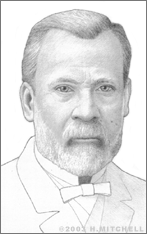Louis Pasteur
Louis Pasteur was born on December 27, 1822 in Dole, a small town in eastern France. As a youngster he showed talent as an artist, but no special ability in school. This changed however, in his high school years, as he became more and more interested in scientific subjects. In 1842, he completed his Bachelor of Science degree at the Besancon College Royal de la Franche with honors in physics, mathematics, and Latin. He moved on to the Ecole Normale Superieure in Paris to study physics and chemistry. He received his doctoral degree in 1847.
Eventually Pasteur would solve such scientific mysteries as the generation of ailments like rabies, anthrax and chicken cholera, and contributing to the world’s first and most significant vaccines. He also described the process of fermentation for the first time, invented the process of pasteurization, and developed important scientific theories such as the germ theory of disease. He began his career working as a chemist, studying the shapes of organic crystals. He was able to prove that the organic molecules with the same chemical composition can exist in space in unique stereo specific forms. And with this work, at just 26 years of age, Pasteur launched the new science of stereochemistry.
Pasteur served on the faculty of science of Dijon briefly and then transferred to Strasbourg University where he met and married Marie Laurent. They would later have five children, three of whom died of typhoid fever. This might have helped motivate Pasteur to save people from diseases later in his career. In 1854, Pasteur was appointed Dean and professor of chemistry at the Faculty of Sciences in Lille, France.
In 1856, the father of one of Pasteur’s chemistry students asked him to help him solve some problems he was encountering in his attempt to make alcohol by fermenting beetroot. Often, instead of alcohol, the fermentations yielded lactic acid. At the time, fermentation was believed to be a pure chemical process in which sugar was transformed into alcohol. But in 1857, Pasteur proved that a microscopic plant caused the souring of milk (lactic acid fermentation). Pasteur was able to prove that living cells, the yeast, were responsible for forming alcohol from sugar, and that contaminating microorganisms found in ordinary air could turn the fermentations sour. Next he identified the microorganisms responsible for both normal and abnormal fermentations, and found that through heating wine, beer, milk, or vinegar briefly, certain living organisms could be killed, thereby sterilizing – or “pasteurizing” – the substances.
This lead to Pasteur's thought that if germs were the cause of fermentation, they could also be the cause of contagious diseases. He began to develop his germ theory of disease, and eventually, to his work on vaccinations. In the 1870s, Pasteur had been attempting to solve the serious problem farmers were having with chicken cholera. The disease could spread through an entire farm in three days. While Pasteur and colleagues had been culturing the cholera microbes and injecting them into test chickens, they found that if they injected the birds with live microbes after they had already been injected with a weaker quantity of the organisms, that they would be unaffected.
This discovery lead Pasteur to wonder if it could also work for anthrax, a disease that was especially devastating to sheep and cattle. In 1881, Pasteur successfully demonstrated his anthrax vaccine to the public. Within ten years more than 3.5 million sheep and a half million cattle had been vaccinated with a mortality of less than one percent. This work lead to Pasteur’s identification of the germs causing many other diseases, such as swine erysipelas, childbirth fever and pneumonia. Pasteur is also credited for installing physicians’ adoption of the rules of antiseptic medicine and surgery.
In 1885, Pasteur was lauded for one of his most famous developments -- a vaccine against rabies (or “hydrophobia”). He had successfully vaccinated dogs against the disease; soon after the vaccine was tested successfully on humans. Subsequently, the Pasteur Institute was built in Paris to treat victims of rabies. Additional Pasteur Institutes were later built around the world to treat with rabies and other diseases.
Pasteur died in 1895 after suffering multiple strokes. He was buried, a national hero, by the French Government in the Cathedral of Notre Dame, and his remains were transferred to a permanent crypt in the Pasteur Institute, Paris.


